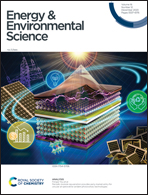Broadening solid ionic conductor selection for sustainable and earth-abundant solid-state lithium metal batteries†
Abstract
A challenging task in solid-state batteries is finding a solid ionic conductor that is simultaneously electronically insulative, stable at both low and high voltages, and sustainable. Current prevalent ceramic lithium-ion conductors (LICs) struggle to balance all these criteria, and their selection is limited for application in solid-state lithium metal batteries. Here, we report a universal solid electrolyte design paradigm, i.e., an ceramic LIC sandwiched between two solid electronic separators, to allow a broad range of ceramic LICs including Li1.5Al0.5Ti1.5(PO4)3, LiV3O8, and Li4Ti5O12, to be deployed in solid-state lithium batteries. With the solid electrolyte design, the requirements of electronic insulation or (electro)chemical stability for ceramic LICs are no longer needed. A high critical current density of 14 mA cm−2 (under a constant plating/stripping capacity of 0.5 mA h cm−2) and long-life cycling (7000 hours at 0.2 mA cm−2 and 2500 hours at 0.5 mA cm−2) were realized in Li//Li symmetric cells at room temperature. Remarkably high capacity retentions (87% after 400 cycles) were also achieved in Li0 full cells paired with LiNi0.8Mn0.1Co0.1O2 cathodes (mass loading: 7.4 mg cm−2). Our discoveries promise the implication of broader-ranging, more sustainable, yet previously unrecognized ionic conductors in practical solid-state batteries.



 Please wait while we load your content...
Please wait while we load your content...